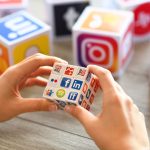
Once upon a time, the luxury experience was inherently tactile. The awe factor of walking through a multimillion-dollar vacation home or sitting behind the wheel of a custom luxury vehicle was only possible in the physical realm. But ever-advancing technology has changed the luxury game.
It’s not a question of whether or not digital works in luxury. You can pick the finishings for your Audi in digital showrooms, try on designer clothes in virtual fitting rooms, or take home tours on your phone. Luxury has already adapted to digital — and with success. Now, the question is how brands in the high-end realm can actually translate their value into this digital space. This will become increasingly important as digital pushes the industry even further into the future.
One challenge in translating physical experiences to digital ones is how to maintain the sense of awe that’s so imperative to luxury products. Virtual reality is one emerging technology that offers solutions here — but brands must go further still to figure out how to personalize the digital experience enough to earn attention and streamline everything they offer.
The luxury in virtual reality
Few industries face the dilemma of translating the emotion of luxury more than real estate. In luxury real estate, we have to think through how we can digitally deliver the feeling of stepping inside, say, a $25 million beachfront property with expansive rooms and floor-to-ceiling windows. What can replace the sublime moment of watching the sunset from the rooftop balcony?
We’ve found that virtual and augmented reality allows us to bridge this gap. VR home tours allow anyone with a smartphone and VR headset to step inside a space, albeit virtually. These kinds of experiences are most certainly in the future: Amazon has already patented a “blended reality” mirror that will allow customers to virtually try on clothing from their own homes. Customers can choose from among different background options to visually transport themselves, making the digital experience vastly more personal than a traditional shopping cart.
That’s an important note for those in the luxury sphere — personalisation is a huge contributor to what makes luxury so, well, luxurious. When an inspiring experience meets a customer’s specific preferences, they’re more likely to pay top dollar for the product. But how can you stay personal on digital channels?
The importance of personalisation
Digital technology has made it possible for every brand — including those that don’t identify with “luxury” — to provide a luxury experience in terms of personalization. Look at Starbucks, for instance: despite its size and ubiquity, loyal customers feel an individual connection to the brand and the baristas who know their drinks.
The coffee giant has digitized this experience masterfully with its loyalty rewards app, which beats out all other restaurant chain apps when it comes to use. Starbucks’ app can record your favorite orders, suggest food pairings, and show you the music that’s playing in the store. It can even suggest nearby locations and place your order for you so it’s ready for pickup when you arrive. It’s almost as if customers have their own personal barista ready to craft the perfect drink, in the perfect spot, at the perfect time. Luxury brands should offer similarly personalized digital experiences to perfectly meet consumers’ needs.
Conversation is the best consumer research
Before you craft a personalized experience, however, you have to know what consumers actually want. This is where the power of conversation comes in — and it’s easier than ever on digital. Consumers value authenticity and are suspicious of anything that feels manipulative, but technology allows brands to take a conversational approach that helps them appear more genuine to audiences while also delivering valuable information about consumer preferences.
Rolls-Royce, for instance, has made an art out of engaging its high-end clientele. The company offers a collaborative design service, Coachbuild, which pairs buyers with design teams to discuss their vision for the ultimate luxury vehicle. The partnership results in a one-of-a-kind bespoke car that’s conceptualized through conversations and driven by the buyer’s passion for the brand. Though not every retailer can offer a Rolls-Royce level of customization, the point still stands: Whenever possible, brands should listen to see what their customers are looking for and respond accordingly.
In the luxury sphere, this is a valuable tool for gauging ever-changing customer preferences and personalizing experiences to meet those needs. In luxury real estate, for instance, agents can have a conversation to assess an individual client’s particular aesthetic and then use that information to virtually stage a home for a 3D tour. This resolves one of the biggest hurdles in real estate — visualization challenges presented by homes that aren’t staged properly for the client in question. By designing experiences according to each client’s taste and presenting the home in an easily accessible format, agents can deliver highly personalized experiences.
Streamlining into the future
As brands learn to translate the luxury experience into the digital realm in more personalized ways, they’ll also need to focus on another key aspect of luxury for online consumers: streamlining offerings. Take the on-demand video business: While brands like Disney launch their own streaming services and splinter the viewing experience for consumers, other players — think Apple TV — consolidate a digital experience to make it easier for consumers to access. Now, instead of requiring viewers to jump between Netflix, Hulu, and Amazon Prime to watch their favorite shows, Apple TV collects them all on its home screen for one-click access.
Mainstream brands take advantage of similar technology on Instagram: Instead of pushing viewers on the social media platform toward their websites, brands such as Nike and Warby Parker use Instagram’s checkout feature to allow customers to purchase straight from their social media feeds (and if interest in custom Porsches is any indication, luxury brands should follow suit). More retailers are likely to join in on social checkout, meaning consumers will soon be able to make purchasing decisions on everything from furnishings to vehicles in one place.
For any brand, the first step of streamlining involves making sure your digital, creative, and marketing teams are aligned; after all, the digital experience needs to drive marketing infrastructure. For instance, your brand’s website and app should work together — not as standalone entities of your brand. If customers find something on your website, that search criteria should still be available when they search using their phones. The goal should be to make each transition, whether it’s from a website to an app or from a potential lead to a client, as seamless as possible.
These streamlined experiences offer another layer of personalization and simplicity to consumers — one where they have a say — which fits right into the essence of luxury. The luxury experience used to be driven by what brands wanted to communicate. But more and more, we see that the consumer wants a say. As buyers seek to have their online shopping curated to fit their preferences, brands that get ahead of this trend will earn an edge.
Digital technology is bringing the luxury experience directly to consumers in ways we’ve never seen. That leaves just one question: Which brands will deliver that experience effectively?

Interested in hearing leading global brands discuss subjects like this in person?
Find out more about Digital Marketing World Forum (#DMWF) Europe, London, North America, and Singapore.






Digital consumption has become ubiquitous. Multimedia device and a internet connection ans you are good to go!
There are so many digital marketing jobs listed on job vacancy results for in the time coming the these jobs will surge dramatically